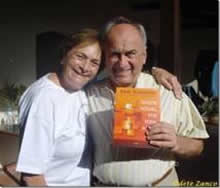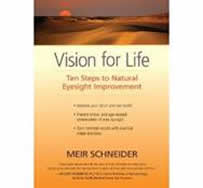Articles

By Sylvia Lakeland at the 24th International Holistic Vision Conference
Villa Cagnola – Gazzada – Italy 2013.
Dearest friends,
I would like to start by thanking you all for having me at this 24th Conference and specially for being here now to share with me a very important moment.
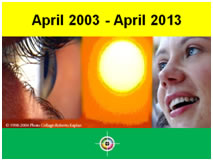
Most of you lived with me the difficult years when my vision got every day worst and as well we rejoiced together when my vision was totally back again for the 19th Conference, in Madeira, 2004!
So let us be happy again at this important anniversary: April 2013 I completed ten years of full recovery of my vision, a surprise even to my eye doctor whom I met last month, in São Paulo. He really did not believe that from less than 5% vision in 2003 in both eyes, I could improve and maintain the results for so long!
And as I can see each one of you sitting here in this beautiful location, let us rejoice with a special HURRAY to my mentor, Meir Schneider and his Self-Healing Method!
Mainly concerned with more movement and coordination, as I always do in Central Parks, I invite you all for a warm up; after all we are now really starting our Conference. So, let us all get up and charge our batteries with good energy.
Some minutes of body and vision practice.
These fascinating 10 years of vision training allowed me to keep a healthy vision while learning every day more, and gave me all the experience I have now to really consider my work as a unique Body and Vision System for Outdoor Training in Parks.
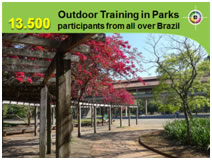
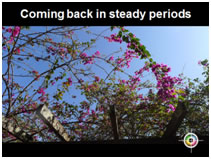
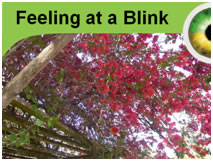
About 13.500 participants from all over Brazil come to São Paulo Parks, two hours twice a week, enjoy the unique experience of more vision and better quality of body and life, and surrounded by lovely red, purple and orange spring flowers, Bougainvillea. Students and interested persons arrive and come back until they are ready to practice on their own and then in steady periods they return, check results and learn more. Great results happen every day along the years!
Feeling at a Blink
Working outdoors with people who arrive for the first time and of course of whom I don't know and have no special information about their vision and personal problems requires to trust my intuition and understand at a blink what are the information I really need and what to let go so not to be distracted by false signs.
To become conscious of these details on a very fast lane, quite a lot of studying is required as well as being all the time concentrated and with total attention, really listening and feeling, being aware with love and understanding. It is also very important to keep a bright sense of humor and lightness in commanding each exercise. Having fun is vital!
Understanding at a blink
It is important to observe the curious reactions of the adaptive unconscious of our minds (Timothy D. Wilson) while generating a great deal of incoming information on all quantum dimensions - sensing, biological understanding, feeling, thinking and intuiting.
Results at a blink
The results are incredible, with an increase of cases with good results in all areas: glaucoma, epiretinal membranes, macular degeneration, dry eyes and floaters, just to mention some different cases. Not forgetting the fantastic posture improvement in most cases, mainly with low vision elderly participants. Most of these cases improve within periods of six months to three years regular participation in the exercises.
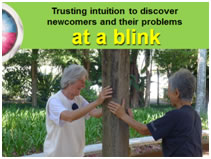
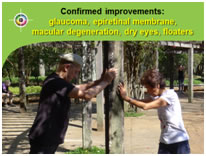
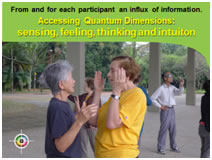
I just participated at the III International Quantic Health Symposium and I would like to share with you an excellent model that is being very useful for me and my way of looking at each student and patient.
Chart 1& 2 - This transdisciplinary model is a new vision introduced by the American nuclear physicist Amit Goswami, who demonstrates the relationship between physics, consciousness and healing. The model was adapted by the Brazilian Doctor Fernando Bignardi and shows the quantic dimensions and how to access them.
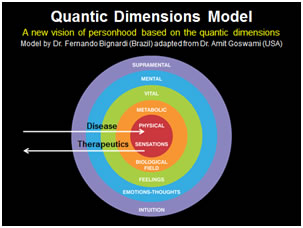
Consciousness is the ground of "Being" in which there are five dimensions of quantum possibilities:
Physical dimension- organs & systems
Metabolic dimension - blood & lymph, connecting systems
Vital dimension - related to the body rhythms: sleep, appetite, breathing
Mental dimension - posture and mental attitude towards inner and external realities;
Supramental dimension - spirituality as the archive of the essential mission and human individuality.
Chart 2&3 – Understanding this model and how it works becomes a very strong instrument to allow us discover immediately where and when health problems start and how they can end.
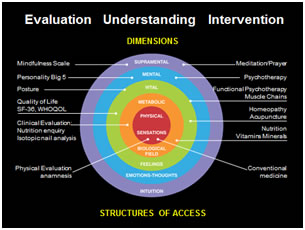
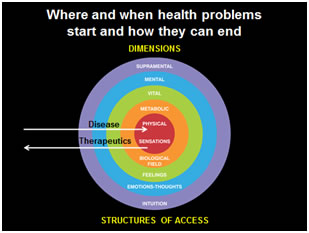
Choice from material possibilities gives us material objects of sensing.
Choices from metabolic possibilities gives us biological understanding.
Choice from the possibility-movements of the vital world, we experience vital energy movements of feeling.
Choice from the mental world, mind, gives us meaningful objects of thought and emotion.
And choice from the supramental gives us the archetypal objects of intuition.
Essentially, Transdisciplinarity is an academic attitude, leading to a new vision of Personhood.
Chart 4 – This model shows us a transdisciplinary framework related to exercise and physical activities
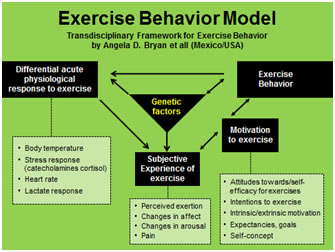
In this framework, genetic factors influence
Physiological responses to exercise (e.g. body- temperature regulation),
The subjective experience of exercise (e.g. perceived exertion),
Potentially directly influence exercise behavior.
Physiological responses may also influence one's subjective experiences.
The subjective experiences will influence motivation to exercise (attitudes, self-efficacy and intentions to exercise).
Importantly, the subjective experiences of exercise include interpretations of physiological changes occurring during exercise (e.g., perceived pain due to increased lactate).
Motivation, in turn, influences exercise behavior and increased exercise behavior (i.e., more minutes of physical activity per week) recapitulates the model, affecting both physiological responses to exercise and, potentially, gene expression.
Therefore, the framework is circular and dynamic.
Chart 5 – This model will show us who is more likely to respond to vision exercises and who is more likely to keep up vision exercises.
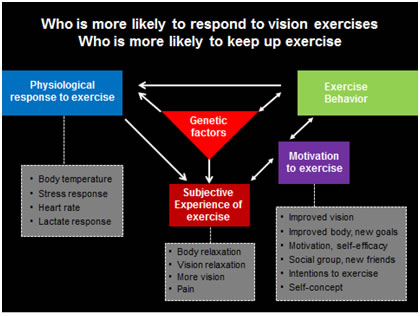
Keeping in mind the different dimensions, these transdisciplinary models, the downward causation of possibilities and understanding the characteristics of each individual, several mechanisms of intervention are proving to be effective in maintaining a regular presence in my classes in the Parks.
But of course some questions remain.
Basic Questions
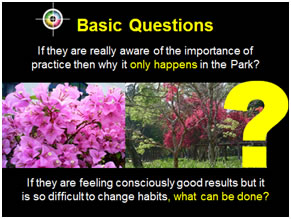
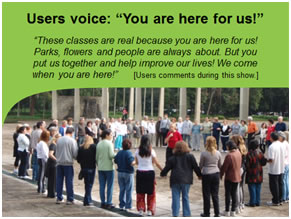
1. Are these participants really aware of the importance of the exercises and the effect on their vision? Why so many only practice in the Park and go home considering their weekly job fulfilled?
2. If they are really enjoying and feeling consciously good results with body and vision improvement, but it is so difficult if even possible to change habits, what more can be done?
Timothy Wilson reminds us of the adaptive unconscious:
"By looking inwards and outwards at one's own behavior and how others react to them, self-examination happens reflecting nonconscious thinking, feeling and motivation".
Conscious strategies at a blink – Taking notes along so many years gives me great feedback to observe and react to relevant details, always a great help:
1. The wonderful natural location helps bring peace and trust
During this first important encounter my concern is to allow each person feel at a blink of the eyes a subjective experience of the exercises and to feel the physiological changes in the body and eyes during this two hours practice. The impact of the outdoors location is always fabulous.
2. The relaxed and committed participation in a welcoming social group
People like to be together, they create a trust bond in a fast way, mainly in this case of vision and body problems when they can share and talk about,
Expanding their motivation to body and eyes exercises during this two hours practice.
Altogether, within their own individual experiences, they are enjoying the sun, flowers, birds and my intervention is transferring trust and commitment, twice a week, for two hours of entertainment and participation.
User's Voice: you are here for us!
When I recently showed this presentation to a group in the Park, they made a point to add their statement:
"These classes are real because you are here for us! Parks, flowers and people are always about. But you put us together and help improve our lives! We come when you are there!"
3. Breathing and Meditation to bring an immediate physiological response and reach the vital and supramental dimensions.
Following Einstein: "the solution of a problem will always be found on a higher dimension", the vital and supramental dimensions must be considered at a blink.
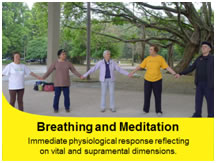
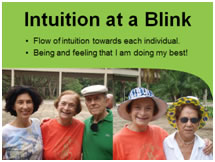
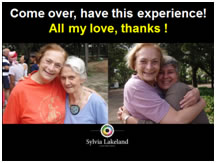
After working thoroughly with flowers and near vision, each class ends with a group meditation with a circle of energy by holding hands, therefore our model flows well with the physiological, psychological and motivational responses on the move!
These subjective experiences influence attitudes and motivation levels grow bringing new commitments of returning for more vision, more sensations of freedom and consciousness. All this will bring better physiological responses, therefore more flexibility, posture and better vision.
Intuition at a blink
I would like to finish this presentation by saying that my challenge is to captivate each participant at the first contact, at the first class.
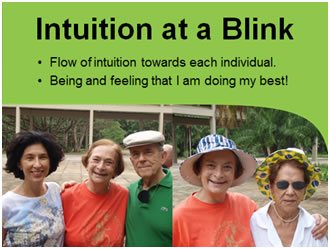
Most people arrive from all parts of town, state and country, usually after a long tiresome and annoying wandering to eye doctors, and when most medical solutions did not bring more vision. "By word of mouth" they hear about possibilities of improving vision with natural exercises. So they arrive for the first time hoping to get more external solutions.
A glance and my intuitive experience flows: there is no need to think, just feel and let all sensations flow towards each individual when we approach, with love and understanding. A motivated brain brings happiness and inspires us always to become what we believe we are.
I have faith that I am helping and doing my best while remembering that we are not alone! Come over, have this experience! Thank you!
Sylvia Loretta Lakeland
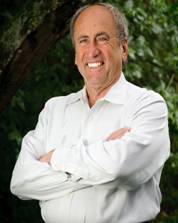
Vision is the total sum of sensation, perception, and conception.
Meir Schneider
While most of us know that we can improve our health and live longer by eating better, getting regular exercise, reducing stress, and learning relaxation, when it comes to our eyes we have a kind of learned helplessness. Very few of us believe there is anything we can do to make our eyes healthier and improve our eyesight.
The exercises on Yoga for Your Eyes (DVD/VHS), www.self-healing.org, are based on the Bates Method, with refinements and additions developed during my nearly three decades of reversing my own blindness and helping others work with their visual problems. These methods have been proven effective in relieving all refractive conditions (any structural problem affecting the trajectory of light within the eye), correcting squints and lazy eyes, and similar problems. They do not necessarily address eye diseases; but they do help you nurture healthier eyes that are more resistant to disease and better able to heal themselves from any reversible condition. Good Vision for Life : Ten Steps to Natural Vision Improvement Meir Schneider’s has a new book "Vision for Life: Ten Steps to Natural Vision Improvement" already in its Portuguese version. Make sure you get your copy of the new book. For the Portuguese edition, please place your order and receive it by mail: adijon@adijon.com.br |


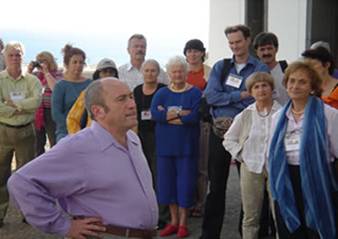
 Among the discoveries Dr. Bates made was how visual clarity changes – in the same person – from good to bad and back again, depending on that person’s physical and emotional state. He concluded that vision is not a static condition, but one that changes constantly. In your own experience, you’ve probably noticed that your vision is better at some times than at others. Dr. Bates was the first ophthalmologist to make a scientific study of this phenomenon. His research shows how vision defects can be created and/or worsened by the stress of everyday situations. He also proved that these problems could be corrected by conscious and correct visual behaviour.
Among the discoveries Dr. Bates made was how visual clarity changes – in the same person – from good to bad and back again, depending on that person’s physical and emotional state. He concluded that vision is not a static condition, but one that changes constantly. In your own experience, you’ve probably noticed that your vision is better at some times than at others. Dr. Bates was the first ophthalmologist to make a scientific study of this phenomenon. His research shows how vision defects can be created and/or worsened by the stress of everyday situations. He also proved that these problems could be corrected by conscious and correct visual behaviour. 